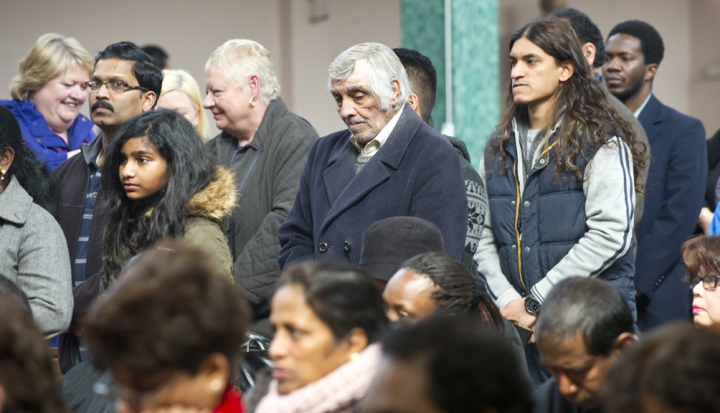Great parishes shared by several ethnicities discover ways to give each group what it needs while also forging unity.
The medium-sized Midwestern parish shared by communities of Mexican immigrants and non-Hispanic whites had two Easter Vigil Masses, one in English and another in Spanish. During the liturgy of the word at the second service, a man made his way up to the priests and quietly spoke to one of them.
Apparently, a car from the current Spanish Mass was blocking the exit of a family who had just left the party for the newly baptized and confirmed that had followed the English Mass. The priest got up after the psalm, read off the license plate, and asked the person to move the car. About five minutes later, another man came up, and again the priest read off the license plate. I felt this was a shocking interruption on this holiest night of the year, but I was merely being welcomed back to the complex world of the “shared parish.”
Shared parishes are Catholic parishes with two or more distinct cultural groups, each with their own Masses and their own set of ministries, but who share the same parish facilities. While there are no firm statistics on these parishes today, in many dioceses in traditional immigrant states like California or Florida, between 50 and 75 percent of their parishes hold Mass in more than one language; in dioceses whose immigrant population has arrived since 1990, it’s about 20 to 50 percent of parishes.
Here are some observations I have made while researching shared parishes across the country.
1. The majority of pastoral activity—worship, ministry, faith sharing, religious education—necessarily takes place in groups specific to each language and culture.
Parishioners can only share faith and make complex decisions together when they can communicate clearly and in considerable depth. Admittedly, this system of “parallel worship and ministry” creates both advantages and challenges.
On the one hand, immigrant groups—especially if they are poor and relatively powerless—need a safe space to live out their Catholic faith, even as they gradually adjust to life in a foreign land. At one parish a Mexican woman visiting from a town without a Spanish Mass wept as she told Spanish-speaking Massgoers, “You don’t know what you have.” Catholics from the dominant culture also need time and space to adjust to the changed demographics of their neighborhoods.
On the other hand, being one parish requires some kind of common reference, a minimally common experience of parish life. How can we have both?
2. Have a common vision of equal partnership.
The cultural groups that gather at shared parishes almost always live unequal lives in the larger society—often due to the effects of economic inequality, a broken immigration system, and racism. But because such inequality is simply assumed in American society, all of us need to be called over and over again to a different experience, an intentional vision of equal partnership among cultures rooted in Christ’s vision of the reign of God. We must be continually persuaded that the last shall be first (Matt. 20:16) and that a parish can operate without favoritism (Acts 10:34).
This is squarely the responsibility of parish leaders and needs to appear in homilies, mission statements, even in short talks to the different groups. As one Mexican American pastor put it to me, his Filipino parishioners had to see and believe that he was “pro-Filipino.” Good leaders also intervene when influential parishioners veer away from a vision of equal partnership. Negativity and clannishness are infectious.
3. Have just and fair procedures for negotiating the use of rooms and worship spaces by the different groups.
These procedures must be fair (where everyone fulfills the same requirements), but they must also be accessible and intelligible to all and address the real needs of all parishioners (for example, room request forms should be available in all major languages).
4. Parish leaders practice and instill empathy in parish life.
Parishioners learn from their leaders to appreciate the fears some groups have about being mistreated or ignored—many people of color feel invisible in parishes—and the worries or grief other groups have because of changing neighborhoods or aging congregations.
Perhaps the most challenging element of this for some is extending empathy to undocumented parishioners. But no shared parish will succeed until the undocumented are seen as parishioners rather than pariahs.
5. Parish committees share power and have appropriate representation.
Equality and justice demand that all Catholics in a parish have an opportunity to participate in ministry and have proportionate representation in parish leadership—whether it is on the pastoral council, school board, stewardship committee, or the finance council.
At one parish in Southern California, leaders in each cultural community—English- and Spanish-speaking Hispanics of different backgrounds and Filipinos—who had served on the parish pastoral council spoke about it nonchalantly, as if a multicultural leadership group that relied on translation were the most natural thing in the world. Pastors at this parish understood that you cannot have only token representation in such groups; people feel safety in numbers.
6. In addition to parallel tracks for different groups, offer common experiences of parish life.
Without some sort of common experience of church, the parallel communities of a shared parish miss something of the true Catholic sense of communion, of that universal bond between Christians created by the Holy Spirit. A parish must be more than a common meeting place.
The pastor at one parish instituted a Saturday morning breakfast amidst the different weekend programs and events. Some of the most powerful experiences occur when people gather to pray and share their faith stories with one another, often using translation to cross the language barrier.
Still, we must acknowledge that most people find social interactions with those from other cultures anxiety producing. Leaders at successful shared parishes know they must develop structured opportunities for people to have a common experience of parish life to transform this anxiety into curiosity and excitement.
7. Gradually grow multicultural liturgies into rich celebrations embraced by the parish.
The most common shared event in a shared parish remains the most
contested—multilingual or multicultural liturgies. Because they alter familiar rhythms and displace familiar elements, people often struggle with them.
A priest once told me that only bilingual people appreciate bilingual liturgies. This is only partially true. Rather, it often takes years to perfect these complex ceremonies. Over time, they move from awkward and repetitive patch-up jobs (often with only token participation by newcomers) to beautifully orchestrated and heartfelt celebrations.
Along the way, worship planners learn to balance different languages and symbols. Priests learn to “code-switch” from one language to another. Congregations learn responses in multiple languages and a cadre of new music. Gradually the resentment and reduced collections give way to tolerance and then joy at the shared experience.
Following the recommendation of Jesuit sociologist John Coleman, I urge parishes new to sharing to commit to a moderate schedule of multicultural liturgies. They are important and must be done, but a parish needs to gradually discover what is “just right” for them in terms of frequency, season, and timing.
If the local bishop permits, they should consider—especially in the
beginning—steering their multicultural Masses away from the high holy days (Holy Week and Christmas) to other key days to which people are less liturgically attached—for example, Pentecost, Thanksgiving, and the parish feast day.
Shared parish life is not easy, but it can be exciting and fulfilling. All of us need to commit ourselves to a lifelong learning process where we grow not only in our appreciation of other cultures and their practice of the Catholic faith but also in understanding of our own cultural expressions of Catholicism, which often remain invisible to us until we compare them.
All cultures have their strengths and weaknesses, but we should not be hasty in deciding what those are. Social scientists call this “cultural humility.” At the Easter Vigil service I described at the beginning, I learned some openness and flexibility from the Mexican priest celebrating the Mass, who remained unperturbed by the unfortunately necessary interruption. It helped me realize that making our baptismal bonds with one another concrete is more than worth the headaches and hassles. In fact, only through these negotiations and struggles do we become a truly catholic church.
This article appeared in the March 2014 issue of U.S. Catholic (Vol. 79, No. 3, pages 34-35).
Want to read about more ways to help your parish become a thriving and engaging community? Here is our Special Section: Best practices for parishes.
Image: Photo courtesy of the Claretians














Add comment